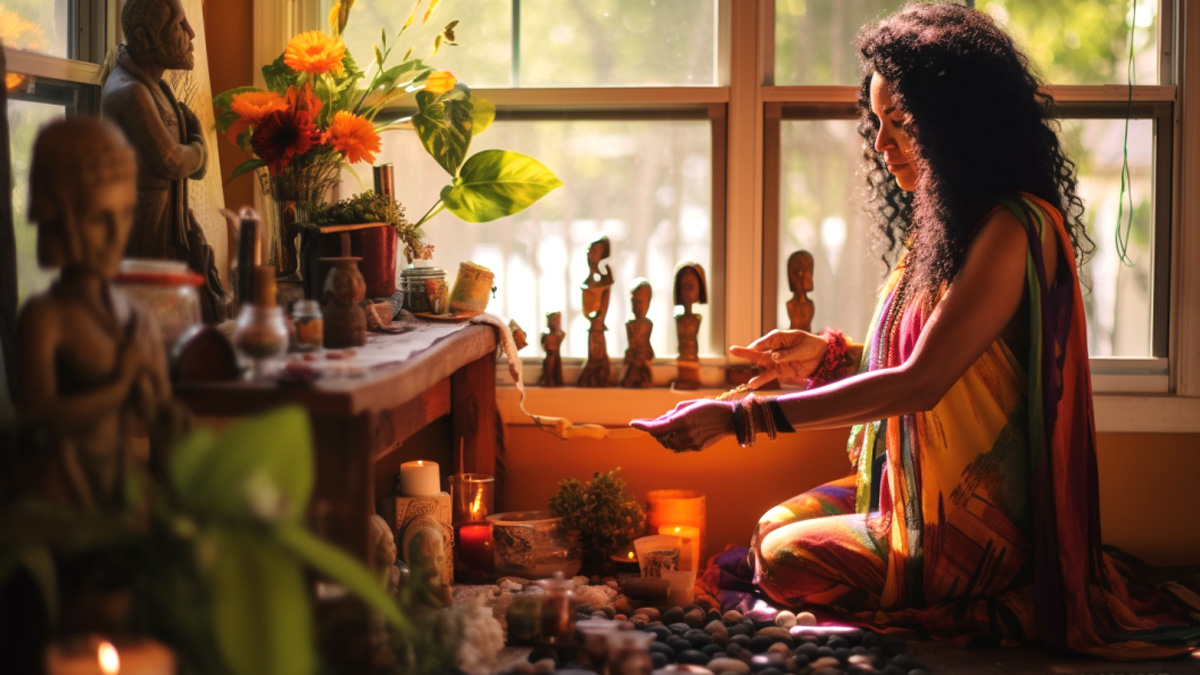Last Updated on September 27, 2024 by Avia
I’ve had altars of some type since I was a kid. Some are outside, some inside. Some I’ve made myself – others I’ve built from repurposed items around the house. In all instances, my altars have helped me strengthen my relationship with myself, the divine, and they’ve helped me move more deftly through various planes of existence. Altars have been such an integral part of my life, that I was aghast that I haven’t written anything about them here on my website. Problem solved. Here are my best tips on how to make an altar, tips on what to put on it, where to place your altar, and tons of other ideas to make your sacred altar the shining star of your spiritual practices.
Table of Contents
- Introduction to Sacred Altars
- What is an Altar?
- What is an Altar Used For?
- Why Would You Want to Make an Altar?
- Do You Have to Be Handy to Make an Altar?
- Best Materials to Incorporate Into Your Altar (and ideas on how to find them)
- Cool Stuff to Place on Your Altar
- Tips on How to Include the Four Elements in Your Altar (and why you should)
- Switching Items on Your Altar (removing or adding items according to the seasons or occasions)
- Tips on Where to Place Your Altar
- Tips on Keeping Your Altar Fresh, Clean, and Energized
- 8 Spiritually-Charged Ideas for What to Do With Your Altar Once It’s Created
- Frequently Asked Questions About Making an Altar and What to Do With It
- The Final Word(s) About How to Make an Altar
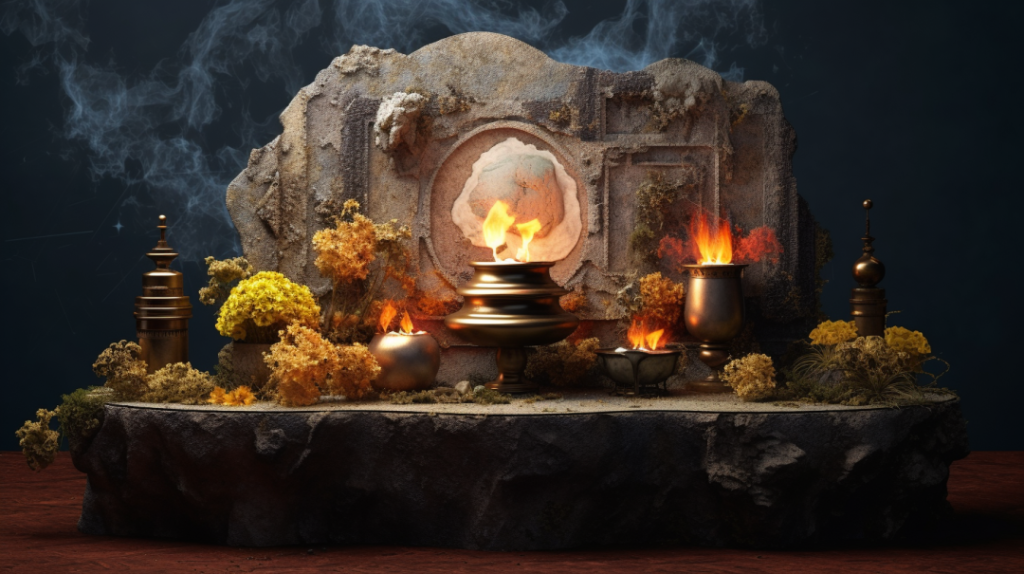
Introduction to Sacred Altars
Whether you’re a seasoned spiritual seeker or just dipping your toes into the realm of sacred spaces, creating an altar can be a powerful tool for deepening your spiritual practice. In this guide, we’ll explore what altars are all about and provide step-by-step instructions on how to make an altar that resonates with your unique energy.
But wait – what exactly is an altar? Is it some elaborate structure reserved for religious rituals? Fear not! Altars come in all shapes and sizes, from simple tabletop setups to intricate outdoor sanctuaries. They are essentially dedicated spaces where you can honor the divine, connect with higher energies, and cultivate inner peace. And guess what? You don’t have to be a skilled craftsman or artiste extraordinaire to create one!
So why would you want to make an altar in the first place? Well, picture this: a serene oasis within your home or garden that serves as a haven for introspection and meditation—a sacred space uniquely yours. It’s like having your own little sanctuary right at your fingertips! Making an altar allows you to infuse intentionality into everyday moments while connecting with something greater than yourself.
Intrigued yet? Great! Throughout this article, we’ll delve into everything you need to know about how to make an altar—from selecting materials that speak to your soul to incorporating the four elements (earth, air, fire, water) into its design. We’ll also explore ideas on what items resonate with different spiritual practices and share tips on keeping your sacred space fresh and energized.
What is an Altar?
An altar is a sacred space designated for a richer connection with spirit, divine energy, and even your inner wisdom. It serves as a focal point for your spiritual practice and physically represents your intentions and beliefs.
An altar is more than just a table or surface adorned with objects; it holds deep meaning and significance. Depending on your preferences and beliefs, an altar can be as simple or complex as you’d like.
Altars have been used by various cultures throughout history, from ancient civilizations to modern-day practitioners. They serve different purposes for different people – some use altars for meditation and prayer, while others use them to honor ancestors or invoke specific energies.
The beauty of creating an altar lies in its versatility – it can be customized to reflect your unique spirituality. Whether you follow a particular religious tradition or have eclectic beliefs, an altar provides a tangible way to express your devotion and create sacredness in your everyday life.
By consciously arranging items on your altar that hold personal significance – such as crystals, statues, candles, and flowers – you are setting the stage for optimal spiritual connections. An altar becomes a visual reminder of what matters most to you spiritually and helps anchor those intentions into reality.
So why not take some time today to explore the idea of making an altar? Dive into this creative process with curiosity and openness. You may find that crafting this special space in your home or outdoors profoundly deepens your connection with yourself and the world around you!
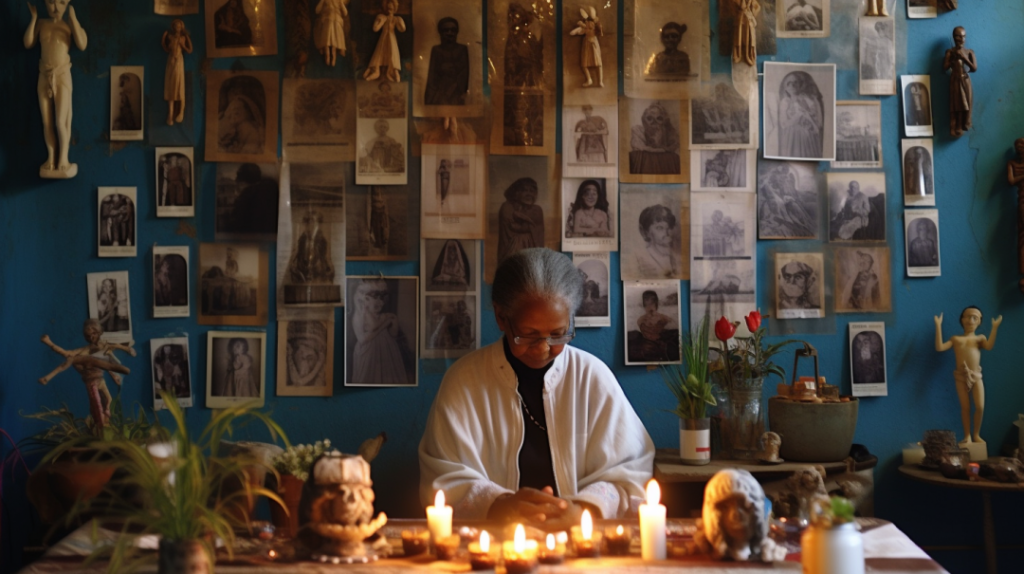
What is an Altar Used For?
An altar serves as a sacred space where you can connect with your spirituality and higher self. It acts as a focal point for meditation, prayer, and reflection. Through the arrangement of meaningful objects, an altar creates a physical representation of your intentions and desires.
Altars are used for various purposes depending on individual beliefs and practices. Some people use altars to honor deities or spiritual beings, while others use them as a place to express gratitude or seek guidance. Altars can also be utilized for rituals or ceremonies to mark important milestones in life.
Creating an altar establishes a designated area that holds positive energy and invites spiritual connections into your life. It becomes a personal sanctuary where you can find solace, inspiration, and clarity amidst the chaos of everyday life.
Whether you follow a specific religious tradition or have a unique spiritual path, making an altar provides a tangible space to cultivate mindfulness and nurture your soul’s needs. It is not just about religious worship but about fostering inner growth and deepening your connection with something greater than yourself.
There are no heavy-hitting rules when it comes to creating an altar – it should reflect who you are on a soul level. So let your creativity flow as you gather items that hold significance for you – whether they be crystals, candles, photographs, meaningful symbols, or natural elements like feathers or shells.
Incorporating these objects onto your altar allows their energy to merge with yours during moments of contemplation or ritualistic practice. The act of arranging these items mindfully fosters intentionality and helps align our thoughts toward our deepest desires.
What an altar is used for depends entirely on how one chooses to engage with it personally. Whether it serves as a place of devotion or simply grounds us in our daily lives by providing moments of stillness amid the chaos—altars give us a chance to bond more intimately with something greater than ourselves.
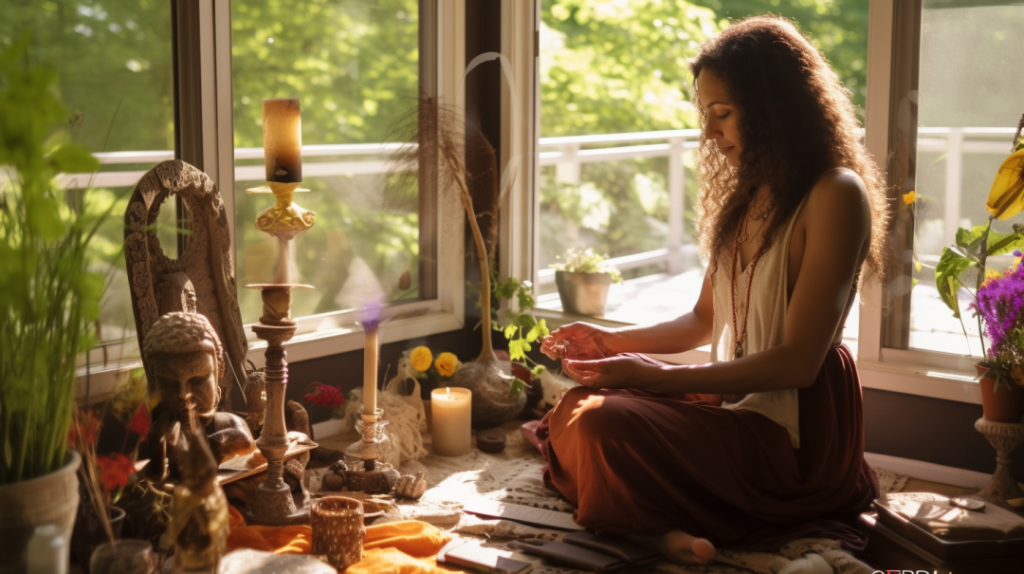
Why Would You Want to Make an Altar?
Creating an altar allows you to establish a sacred space where you can connect with your spirituality, higher power, or the divine energy that resonates within you. But why would you want to make an altar in the first place? Well, there are many reasons!
Focus
Having an altar provides a physical focal point for your spiritual practice. It serves as a visual reminder of your commitment to nurturing your spiritual growth and connecting with something greater than yourself.
Personal Space
Making an altar gives you the opportunity to craft a custom, personalized space that expresses your unique beliefs and intentions. Whether it’s honoring specific deities, ancestors, or simply representing elements of nature that hold significance for you – the possibilities are endless.
Manifesting
Furthermore, altars serve as powerful tools for manifestation and intention setting. By placing symbolic objects on your altar that represent what you desire or wish to manifest in your life, you invite those energies into your space and amplify their presence.
Serenity
Additionally, altars offer solace during challenging times. They provide a sanctuary where you can retreat when seeking guidance or comfort. Lighting candles or offering prayers at your altar can bring peace and clarity amidst chaos.
Mindfulness
Moreover, creating an altar cultivates mindfulness by encouraging regular meditation or reflection practices. Having a designated spot dedicated solely to quiet contemplation helps foster inner stillness and promotes self-awareness.
Grounding
Lastly, but certainly not least importantly, altars provide a sense of grounding and connection to nature’s elements – earth, air, fire, and water. Incorporating these elemental representations onto our altars helps us align ourselves with their energy flow, which further enhances our spiritual journey
So whether it’s about deepening your spirituality, tapping into universal energies, or simply finding peace within yourself-creating an altar offers countless benefits. It invites magic, symbolism, and reverence into our lives.
Do You Have to Be Handy to Make an Altar?
Heck no! If it did, I’d be smooth out of luck, because I’m about as handy as a wet towel. So, no. Creating an altar doesn’t require any special handyman skills. In fact, anyone can make a beautiful and meaningful altar with just a little creativity and intention. There’s no need to be a master craftsman or have access to fancy tools.
Making an altar is not about perfection but creating a sacred space that resonates with your spiritual journey. It’s all about personal expression and connection.
If woodworking or DIY projects are not your cup of tea, consider repurposing items from around your home for your altar. Maybe you have some sentimental trinkets or heirlooms that hold deep meaning for you – these could be perfect additions to your sacred space! I’ve made an altar out of rocks, I’ve used an old steamer trunk I found in a dusty attic, and I’ve even used a cool tree stump. No rules. Just right!
So, no matter how “handy” you may feel, remember that making an altar is more about tapping into your intuition and expressing yourself than it is about technical expertise. With a little imagination and intention, anyone can create their own unique sacred space!
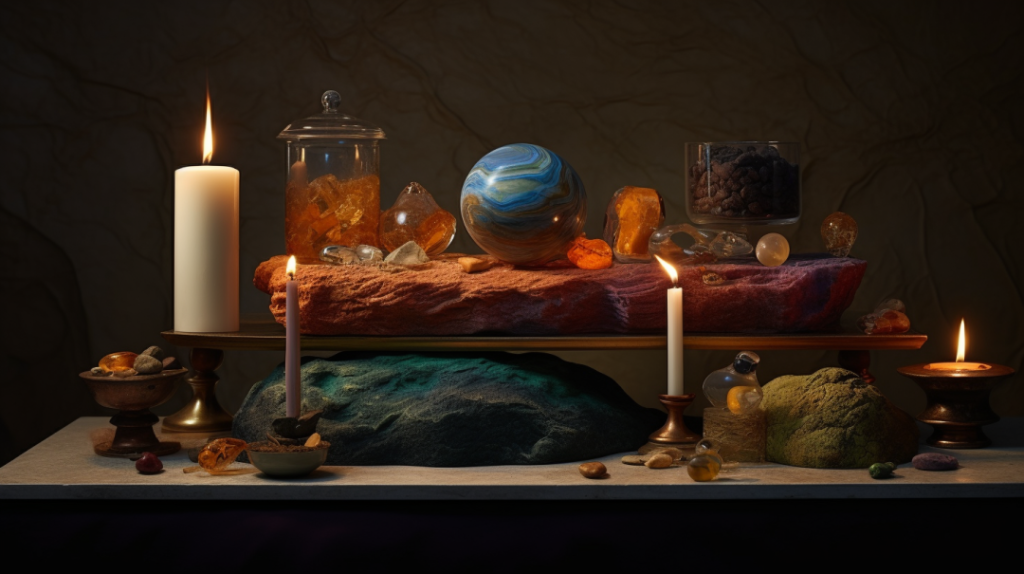
Best Materials to Incorporate Into Your Altar (and ideas on how to find them)
When it comes to creating an altar, choosing the right materials is essential for setting the right energy and ambiance. Consider different options, depending on your personal preferences and what resonates with you spiritually. Here are some ideas on the best materials to use for your altar and how to find them.
Natural Elements
Incorporating natural elements like stones, crystals, seashells, or plants can bring a grounding and earthy energy to your altar. You can find these items by taking nature walks or visiting local stores that specialize in spiritual or metaphysical supplies.
Sacred Symbols
Including sacred symbols such as statues of deities, religious icons, or meaningful talismans can enhance the spiritual connection of your altar. Look for these items at specialty shops or online retailers that cater to specific traditions or belief systems.
Personal Items
Adding personal items that hold sentimental value can infuse your altar with your unique energy and intentions. These could be photographs of loved ones, mementos from significant events in your life, or objects that represent your passions and interests.
Ritual Tools
Depending on the type of spiritual practice you follow, incorporating ritual tools like tarot cards, candles, incense holders, chalices (for water), athames (ritual knives), or wands can add a ceremonial aspect to your altar space. These tools can often be found at metaphysical stores or online platforms specializing in pagan supplies.
Trust yourself and choose whatever speaks to you personally! The most important thing is that each item holds significance for you and helps create a sacred space where you feel connected to something greater than yourself.
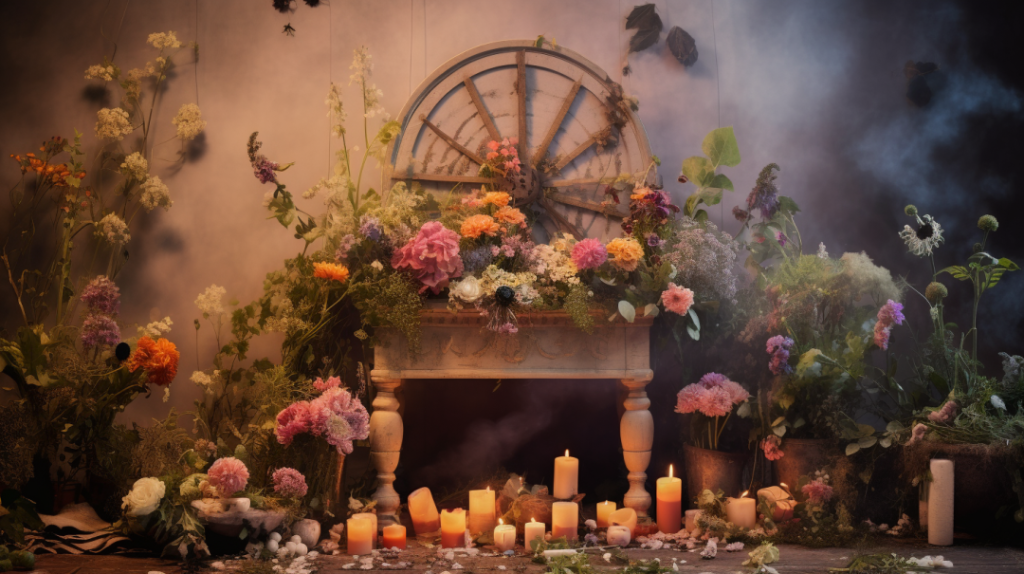
Cool Stuff to Place on Your Altar
When it comes to creating your altar, deciding what to place on it can be a deeply personal and meaningful process. The items you choose should reflect your intentions and desires for optimal spiritual connections. Here are some ideas to inspire you:
Candles
Lighting candles on your altar adds a soothing ambiance and symbolizes the element of fire, representing transformation and illumination.
Crystals
Crystals hold powerful energy and can enhance the vibrations of your sacred space. Choose crystals that resonate with you personally, such as clear quartz for clarity or amethyst for spiritual connection.
Sacred Objects
Incorporate objects that hold special meaning for you. It could be a piece of jewelry passed down through generations or a memento from a significant event in your life.
Incense or Sage
Burning incense or sage purifies the air and creates an atmosphere conducive to meditation and spiritual practice.
Plants or Flowers
Adding living elements like plants or fresh flowers brings vitality and nature’s energy into your sacred space.
Symbols of Deity
If you have specific deities or higher powers that resonate with you, consider including symbols associated with them on your altar as a way to connect with their energies.
Personal Offerings
Leave offerings on your altar that are meaningful to you. It could be something as simple as a handwritten note expressing gratitude or a small token of appreciation.
Tarot Cards or Oracle Decks
If divination is part of your spiritual practice, having tarot cards or oracle decks readily available on your altar can help facilitate intuitive guidance and insight.
Inspirational Quotes or Affirmations
Displaying uplifting words that resonate with you can help create a positive atmosphere around your altar space. Write them down on small cards or find printed quotes that speak to your soul.
Artwork or Crafts
Consider creating pieces specifically for your altar space if you’re artistically inclined. Whether it’s paintings, sculptures, or handmade crafts, infusing art into your sacred area adds another layer of self-expression.
Personal Mementos
Consider adding items that hold sentimental value or remind you of special moments in your life. This could be a seashell from a memorable beach trip or a photo of loved ones.
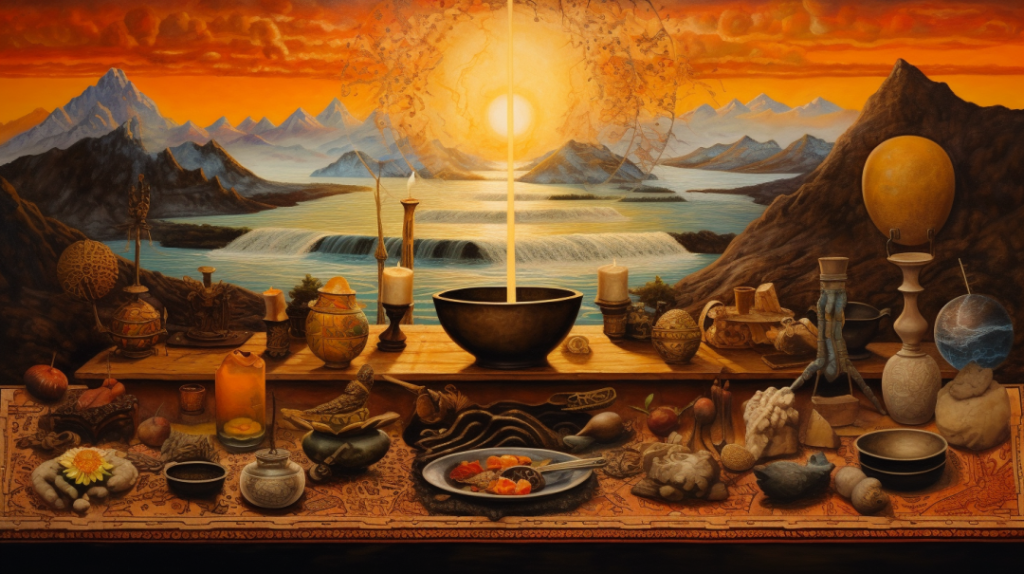
Tips on How to Include the Four Elements in Your Altar (and why you should)
Creating an altar is a beautiful way to connect with your spiritual side and invite positive energy into your space. One powerful way to enhance the energy of your altar is by incorporating the four elements – Earth, Air, Fire, and Water. Here are some tips on how to include these elements in your sacred space:
Fire
Symbolizing transformation and passion, Fire can be represented by candles or even a small bonfire outside if safety permits it. Light a candle when you sit at your altar for reflection or meditation.
Earth
Represented by crystals, stones, or plants, Earth brings stability and grounding energy to your altar. Place a small dish of soil or rocks on your altar as a symbol of this element’s presence.
Air
The element of Air is associated with intellect and communication. To incorporate it into your altar, consider adding feathers or incense sticks that can be lit during meditation sessions.
Water
Flowing water represents emotions and intuition. You can include this element on your altar through shells collected from the beach or a small bowl filled with water.
If you lean towards Asian-based spiritual practices, you can also include wood and metal, which are part of the Wu Xing five traditional elements.
Switching Items on Your Altar (removing or adding items according to the seasons or occasions)
Creating an altar is a deeply personal and ever-evolving practice. One way to keep your altar fresh and energetically aligned is by periodically switching out items based on the changing seasons or special occasions in your life. Doing so allows you to tap into the unique energies of different times and infuse your sacred space with renewed vitality.
As the wheel of the year turns, our connection with nature ebbs and flows. Consider incorporating elements that reflect each season’s essence onto your altar. For example, you might adorn spring with fresh flowers symbolizing rebirth and growth. In summer, shells from beach trips could evoke relaxation and joy.
Special occasions also offer opportunities for alteration. Birthdays, solstices, full moons—these moments call for intentional shifts in energy representation on your altar. Swap out objects that have outlived their purpose and replace them with new ones that resonate more strongly at that particular time.
There are no hard rules when it comes to switching items on your altar; trust yourself to follow what feels right intuitively! Trust that as you engage in this process of change within your sacred space, you are actively nurturing a dynamic relationship between yourself and the divine forces around you.
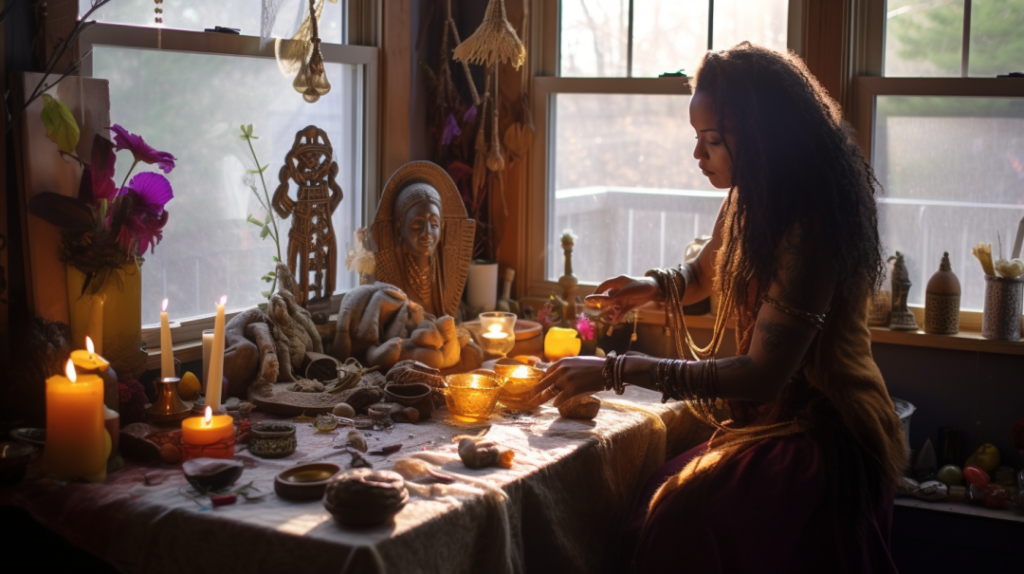
Tips on Where to Place Your Altar
Choosing the perfect location for your altar is important in creating a sacred space. Here are some tips to help you find the ideal place:
Consider the energy flow
Look for a spot that feels harmonious and peaceful. Pay attention to how the energy flows in that area of your home or outdoor space.
Natural light
Opt for a location with good natural light, as it can enhance the vibrancy and energy of your altar. Sunlight can also symbolize divine illumination.
Privacy
It’s important to have privacy when connecting with your spiritual practice. Choose an area where you can retreat and focus without distractions or interruptions.
Accessibility
Make sure your chosen spot is easily accessible so you can approach it comfortably whenever you wish to engage with it.
Symbolic significance
Consider placing your altar in a location that holds personal and symbolic meaning for you, such as near a window overlooking nature or by a favorite tree outside.
Elemental balance
Take into account the elements when deciding on placement – aligning certain directions (north, south, east, west) with corresponding elements (earth, fire, air, water) can add depth and balance to your altar.

Tips on Keeping Your Altar Fresh, Clean, and Energized
Now that we’ve talked about how to make an altar, and stuff you can do with it – let’s touch on keeping your altar fresh and invigorating. You might think the altar itself and the items on it are inanimate. Technically – that’s true. But the energy imbued in an altar and it’s components are susceptible to getting stale. To avoid old, stodgy energy – follow these tips:
1. Regular cleansing: Just like our physical spaces need regular cleaning, so does your altar. Dusting off any debris or wiping down the surface can help maintain its cleanliness.
2. Energy clearing: To keep your altar energetically charged, consider using natural elements such as sage or palo santo to cleanse the space regularly. This helps remove any stagnant energy and invites fresh vibrations.
3. Seasonal adjustments: As the seasons change, you can switch up the items on your altar to align with the energies of that particular time of year. For example, you might incorporate symbols of growth and renewal during spring.
4. Intentional placements: Be mindful when adding new items to your altar – each one should personally have a purpose and meaning for you. Consider how different objects interact with each other energetically.
5. Natural materials: Opt for organic materials like crystals, shells, feathers or dried flowers on your altar instead of synthetic ones, which may carry less energetic resonance.
6. Sacred rituals: Regularly engage in meaningful rituals around your altar to infuse it with intention and positive energy. This could involve lighting candles or saying prayers that resonate with you.
Maintaining an optimal connection with your spiritual practice requires regular attention and care toward your sacred space – keeping it fresh, clean, and energized will enhance its power in supporting your journey!

8 Spiritually-Charged Ideas for What to Do With Your Altar Once It’s Created
When you have created your sacred altar, it becomes a space that holds powerful energy and meaning. It is not just a decorative piece but a tool for spiritual connection. Once your altar is set up, there are many spiritually-charged ideas on what you can do with it to enhance your practice and deepen your connection.
1. Meditate
Your altar can be the perfect place for quiet reflection and meditation. Sit in front of it, close your eyes, and allow the energy of the items on your altar to guide you into a state of deep relaxation.
2. Offerings
Consider making offerings to deities or spirits that resonate with you. You can leave fresh flowers, candles, incense, or even food as an offering on your altar as a way to express gratitude or ask for guidance.
3. Rituals and Ceremonies
Use your altar as a sacred space for performing rituals and ceremonies that align with your beliefs and intentions. Whether it’s celebrating solstices or full moon rituals, creating meaningful ceremonies at your altar can bring depth to your spiritual practice.
4. Journaling
Keep a journal by your altar where you can write down thoughts, dreams, or prayers before or after engaging in spiritual practices such as meditation or divination.
5. Divination Practices
If you are interested in divination tools like tarot cards or runes, use them at your altar when seeking guidance from higher powers or exploring deeper insights into different aspects of life.
6. Energy Clearing
Regularly cleanse the energy around and within yourself using methods like smudging with sage or palo santo while standing near or holding specific items from your altar.
7. Healing Work
Utilize the healing energies present at our altars by conducting self-healing practices such as Reiki sessions near its vicinity.
8. Creative Expression
Your sacred space may inspire creative endeavors! Painters might find themselves inspired while glancing at their altar, and writers might find new ideas flow effortlessly while sitting in front of it.
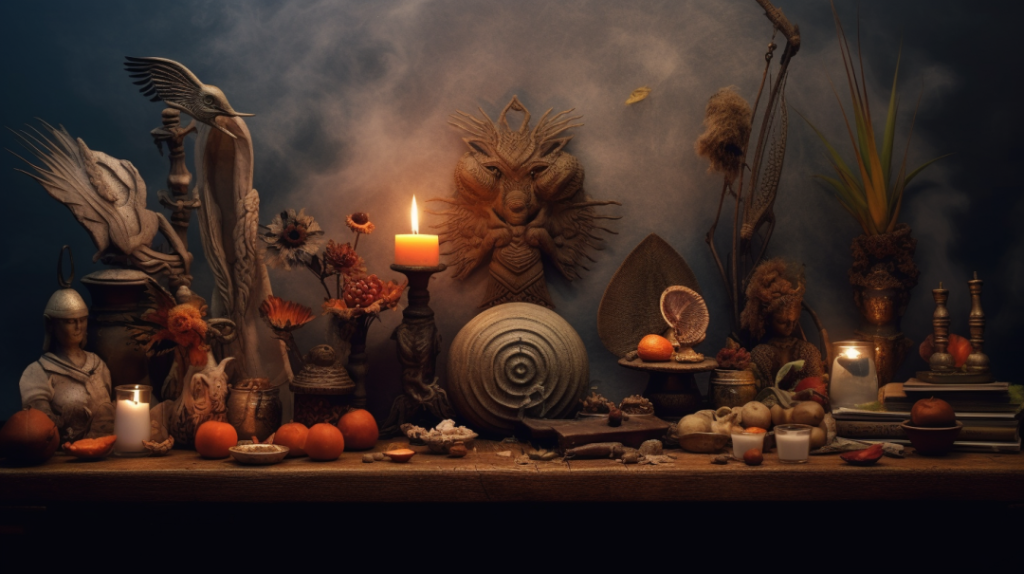
Frequently Asked Questions About Making an Altar and What to Do With It
Indubetibly! Altars are not solely for religious purposes. They can be tailored to suit your personal beliefs, spirituality, or simply as a sacred space for reflection and mindfulness.
Consider a quiet corner of your home where you feel most at peace. It could be a bedroom, living room, or even outdoors in nature if weather permits. Trust your intuition when selecting the best spot.
The items you choose should hold significance and resonate with you personally. This could include crystals, candles, flowers, artwork, photographs of loved ones or spiritual figures – anything that brings you joy and serves as a reminder of what is important to you.
There’s no set rule – it really depends on how frequently you use it and the energy flow in that space. Generally speaking, aim to cleanse your altar regularly by dusting off any debris and wiping down surfaces with natural cleansers like sage or essential oils.
Absolutely! Many people enjoy switching out elements based on holidays, solstices/equinoxes, or personal milestones such as birthdays or anniversaries. This allows for a dynamic connection between yourself and the energies present at different times of the year.
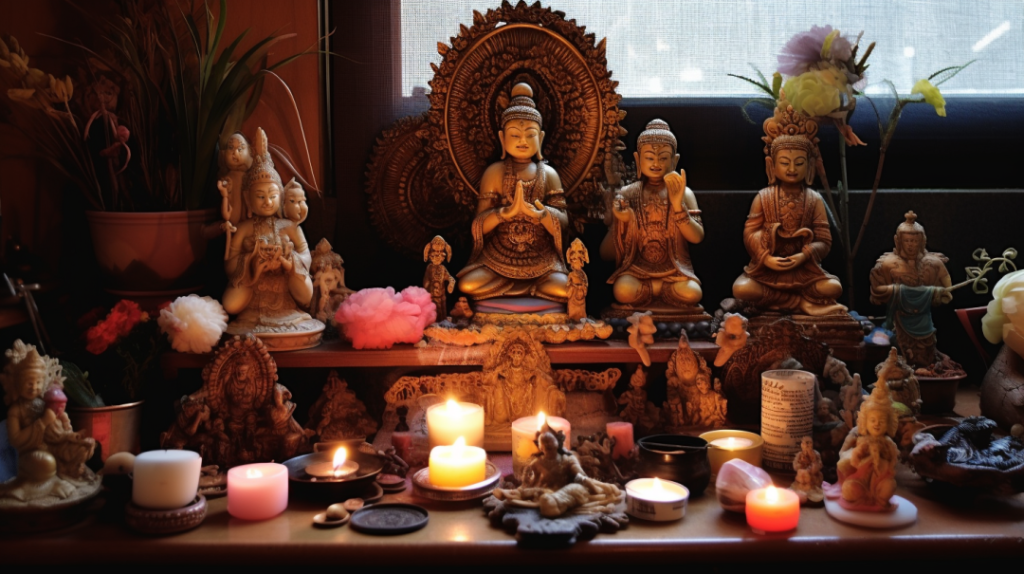
The Final Word(s) About How to Make an Altar
Creating an altar is a deeply personal and spiritual practice that can enhance your connection with the divine and cultivate a sacred space within your home. By understanding what an altar is, its purpose, and how to construct one using meaningful materials, you can better approach a solidified path of self-discovery and spiritual growth.
Remember that there are no set rules when it comes to making an altar. It should reflect your unique personality, beliefs, and intentions. Whether you choose to include elements from nature, symbolic objects, or religious artifacts, let your intuition guide you in selecting items that resonate with your soul.
In creating an altar for optimal spiritual connections, you open up a world of possibilities for deepening mindfulness, personal growth, and connecting with something greater than yourself. So dive into this creative process, enjoy every step, and embrace all that unfolds along the way. As always, thanks for reading!
Mighty brightly,

© Copyrighted. All Rights Reserved.
Avia’s Amazon Picks for You
Sharpen Your Symbol Savvy With These Amazon Selections
Elevate Your Meditation With These Amazon Selections
Want more? Me too! That’s why I’ve also got this for you on Whats-Your-Sign:
